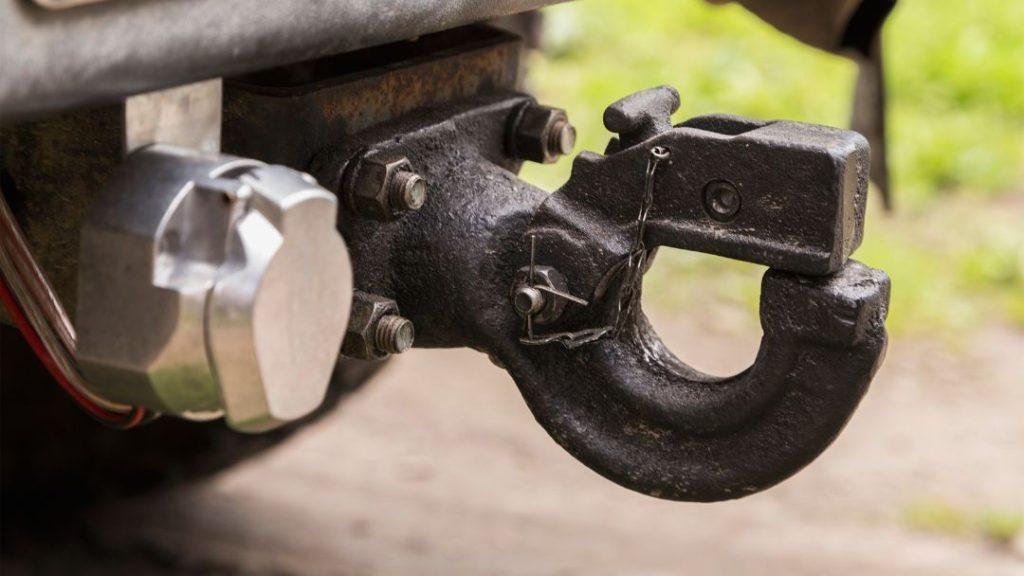When it comes to towing large loads, the importance of a pintle hitch is something that cannot be understated. This piece of hardware can mean the difference between a safe journey and one fraught with potential hazards.
This article serves as a comprehensive guide for understanding the different sizes of pintle hitches and how to choose the right one for your needs.
Basics of Pintle Hitches
A pintle hitch is a type of towing hitch that allows for more articulation compared to a ball hitch. This increased flexibility makes it ideal for towing on uneven terrain or in off-road situations. Pintle hitches come in various sizes, including but not limited to 2-5/16″, 2″, and 1-7/8″. Understanding these sizes and their specific uses is key to choosing the right pintle hitch.

Factors to Consider When Choosing a Pintle Hitch
Gross Trailer Weight (GTW)
Gross Trailer Weight refers to the total weight of the trailer and its cargo. The size of the pintle hitch you choose must be able to support this weight. To determine your GTW, you can load your trailer as you typically would for transport and then use a commercial scale.
Tongue Weight (TW)
Tongue Weight is the amount of weight that the trailer puts on the hitch itself. The proper balance of the TW is crucial for maintaining control of the vehicle and trailer. You can measure TW using a specialized scale or a common bathroom scale with a bit of simple mathematics.
Type of Trailer
Different types of trailers often have different hitch requirements. A flatbed trailer might have different requirements compared to a dump trailer. Be sure to check the trailer manufacturer’s guide for specific hitch recommendations.
Type of Vehicle
The type of vehicle used for towing also plays a role in the hitch size you need. Larger vehicles like trucks and SUVs may require larger pintle hitches compared to smaller cars or vans.
Towing Application
The application of towing is another crucial consideration. If you are towing heavy construction equipment through rough terrain, you will likely need a larger, more robust pintle hitch compared to someone towing a small boat on paved roads.
Safety Considerations
Choosing the right pintle hitch size is not just about efficiency; it’s also a critical safety concern. An incorrectly sized pintle hitch can cause trailer sway, loss of control, or even cause the hitch to break, leading to potentially dangerous situations.
How to Measure for a Pintle Hitch
Measuring for a pintle hitch doesn’t require many specialized tools. You’ll need a tape measure, a piece of paper, and a pen.
- Start by measuring the height from the ground to the base of the trailer coupler or lunette ring when the trailer is level.
- Then measure the height from the ground to the vehicle’s hitch receiver.
- The difference between these two measurements will give you the desired hitch height.
Once you have these measurements, you can match them with the hitch sizes available on the market.
Most Common Pintle Hitch Sizes and Their Uses
Here’s a brief overview of the most common pintle hitch sizes and their uses:
- 1-7/8″ Pintle Hitches: Ideal for lighter applications like small boat trailers or utility trailers.
- 2″ Pintle Hitches: Suitable for medium-duty tasks like towing campers, car haulers, or small equipment trailers.
- 2-5/16″ Pintle Hitches: Perfect for heavy-duty applications like construction equipment, large boat trailers, or horse trailers.
Mistakes to Avoid When Selecting a Pintle Hitch Size
One common mistake is the belief that ‘bigger is always better.’ While a larger hitch will certainly be able to support more weight, it also may not fit correctly with your trailer, leading to potential issues.
Another mistake is not taking into account the TW or GTW when choosing a hitch. These factors are crucial to ensuring safe and effective towing.
Lastly, not checking the vehicle’s towing capacity is another common pitfall. Your vehicle must be capable of supporting the weight you plan to tow.
Conclusion
Choosing the right pintle hitch size is essential for safety, control, and efficient towing. Understanding the various factors involved, from the type of vehicle and trailer to the GTW and TW, can help guide you in making the correct choice. Always prioritize safety and make sure your chosen hitch can handle the job at hand.
Frequently Asked Questions
- What is a pintle hitch?
A pintle hitch is a type of towing hitch that provides more flexibility than a ball hitch, making it ideal for uneven terrain or off-road towing. - What are common pintle hitch sizes?
The most common pintle hitch sizes are 1-7/8″, 2″, and 2-5/16″. - How do I measure for a pintle hitch?
You measure the height from the ground to the base of the trailer coupler or lunette ring, and then from the ground to your vehicle’s hitch receiver. The difference between these two measurements will give you the desired hitch height.
Remember, choosing the right pintle hitch is more than just a logistical decision – it’s a matter of safety. Take the time to measure correctly, understand your requirements, and choose a hitch that will ensure a safe and smooth towing experience.
References




